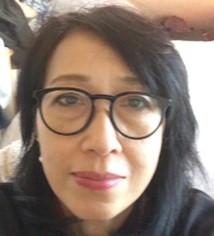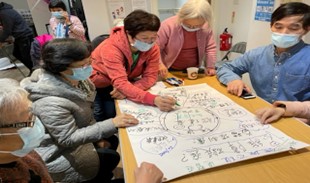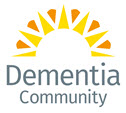Engaging with UK Chinese communities about dementia.
Lim JNW (2023) Engaging with UK Chinese communities about dementia.Journal of Dementia Care 31(5)26-28.
Author Details

Dr Jennifer NW Lim is senior lecturer in public health, researching on health inequalities in accessing care and services for people from culturally diverse backgrounds, at the University of Wolverhampton
Talking about “brain health” rather than “cognitive deterioration” may be a better way to initiate conversations about dementia in communities where the terms used to describe dementia are highly stigmatising. Jennifer Lim describes how she implemented the Chinese Think Brain Health Project to increase understanding of dementia and brain health among Chinese communities in the UK.
Key points
- Apply a positive thought-flipping technique in communicating messages, to break down negative thinking.
- If possible, use researchers and experts with the same culture who speak the same language and use familiar imagery to implement interventions in the community.
- Collaborate with community organisations to access their members, and provide training to sustain awareness activities.
- Don’t stop at raising awareness: extend to reinforcing knowledge through co-creation of tangible products or materials for local dissemination, leading to empowerment.
- Make full use of the opportunity to promote and motivate ongoing research participation from the community.
The Chinese population in the UK has reached over 600,000 (UK Government 2023a, 2023b). The Hong Kong Chinese have been the largest group in this population ever since the 1950s, and now include recent migrants. Other Chinese migrated from Malaysia, Singapore, and Vietnam in the 1970s; and China in the 2000s (Wikipedia 2023).
There is great diversity among us, in our historical, political, and educational background; spoken and written languages; cultural practices; food; and previous experience of health and social care. A significant difference is our languages, particularly between the Hong Kong and China Chinese, where communication requires interpretation/translation.
Hong Kong Chinese speak Cantonese while China Chinese speak Mandarin; the former write in Traditional Chinese language while the latter use Simplified Chinese language. The medical term for dementia is pronounced as chi ngoi zing in Cantonese and chi dai zheng in Mandarin. There are yet more language differences between Chinese people from Malaysia, Singapore and Vietnam. The differences between us, based on our country of origin, affect the way we socialise and relate to other Chinese groups.
Our communities have experienced discrimination and racial harassment. Being brought up to follow Confucius’ teaching, our attitude is to “keep your head down and work hard”. As ‘foreigners’, we tend to be self-reliant and keep to ourselves, hence we are perceived as a ‘silent’ community. We are scattered in small numbers across the country, and as a minority group, we are often neglected by funders and invisible to service providers.
Chinese people and dementia
There are 2,720 Chinese people over 65 years living with dementia in the UK, and this number is expected to rise to over 4,000 people by 2025 (UK Government 2023a). However, there are no official data about the number who have a diagnosis and/or have accessed dementia services. There is also little research in this population. I have found only one small study, involving nine Chinese carers (Baghirathan S et al 2000), compared with more than thirty studies on the South Asian and Black communities, reporting on diagnosis, prevalence, knowledge, experience, and interventions (Lim, in press).
Think Brain Health campaign
In January 2021, Alzheimer’s Research UK (ARUK) launched their first public health campaign, Think Brain Health. This digital campaign has three elements: a quiz to raise appreciation of brain health; three simple rules to keep a healthy brain (“Love your heart, stay sharp, keep connected”), and, finally, “four things you need to know about dementia”.
This campaign is relevant to minority ethnic communities because, by focusing on brain health rather than on a condition that causes the brain to deteriorate, it addresses the social stigma which may prevent people from seeking help.
For Chinese people, the positive “thought-flipping” term “brain health” can break negative thinking about dementia, shifting attention away from the derogatory and stigmatising Chinese medical term (Chi ngoi zing) to achieve the goal of improving access to health services.
However, to be useful to us, the original brain health campaign needed adaptation to make it culturally appropriate, and had to be implemented largely in person, to overcome digital exclusion.
Chinese Think Brain Health project

To bridge the above gaps, I organised a network to bring the Chinese communities across the country together and successfully created a coalition with Chinese community organisations in five cities with the highest Chinese populations (London, Manchester, Birmingham, Liverpool and Bristol). To create a credible dementia research team, Professor Richard Cheston and Mei Champ from the
University of the West of England joined the coalition. Together, we secured the ARUK Inspire Gold Award for one year to conduct the first nationwidedementia and brain health project focused on Chinese people.
Our project aimed to increase knowledge of dementia and good brain health amongst the UK Chinese population and build capacity in local communities. We collaborated with community partners to deliver fifteen workshops in the five cities, in which participants learned about brain health and dementia and were then asked to co-design culturally appropriate information posters and leaflets. We distributed 30 posters and 900 leaflets that were produced in these workshops. Additionally, 105 Chinese people across the country completed our online national survey; and two experts presented in Chinese languages at a national capacity-building webinar. We also formed a Chinese network for future work.
Cultural tailoring and community collaboration
I tailored the project with the aim of improving help-seeking, by including information about normal ageing; Chinese terms for dementia and definitions of dementia; four common types of dementia; symptoms; and causes.
In our presentations, we explained the importance of our public health goal. We worked closely with our community partners to plan the delivery of each workshop, including agreeing which language and which term for dementia should be used. We used Chinese images and examples, and took account of cultural, social, historical, environmental, and psychological factors that influence health behaviour, because addressing these factors can lead to attitudinal and behavioural change.
We spoke in Cantonese or Mandarin to suit our participants in the workshops, and produced four different versions of our information materials to meet language needs and our partners’ preferences on which dementia term to use.
We scheduled activities (hours, location) to suit members of the local community, and we provided incentives such as a participation fee and/or lunch and refreshments, to ensure retention throughout the three workshops.
Participants in the workshops said:
“Using my spoken language in delivering the messages really has transformed this health promotion event.”
“Having someone from Chinese culture develop and lead the sessions made discussions more engaging and we feel free to express our views.”
Additionally, Mei Champ tailored and translated the ARUK Think Brain Health quiz and online Dementia Attitudes Monitor questionnaire into both Simplified and Traditional Chinese.
We found there was no one term for dementia that everyone agreed on. Many in the workshops preferred Nou teoi faa zing; some liked the medical term Chi ngoi zing. We found similar results in our national survey: a third (37.1%) preferred Chi ngoi zing, 16.1% Sat zi zing, 49.5% Nou teoi faa zing, and 24.8% Teoi zi zing, while 31.4% accepted all the terms, and 10.4% wanted other terms.
However, we did create attitudinal change in the workshops about the Cantonese medical term for dementia, Chi ngoi zing. These participants said:
“If other terms are used instead of Chi ngoi zing, many people have no idea what it is …”
“Although it does not sound good, we can attract people’s attention … that this is a real disease, it can be prevented …”
“If we always say that the word is not nice, we are avoiding the problem.”
Co-designing materials
In each city, we implemented three workshops to co-design information materials, using the “What? So what? And now what?” structure. In the first workshop we presented information about the Chinese Think Brain Health campaign and why it is important; in the second workshop participants co-designed posters and leaflets to raise awareness about dementia and brain health; and in the third, we evaluated participants’ experience. We also provided information on the importance of research participation, and facts on dementia research in this population and other minority ethnic communities.
For the co-design session, we repeated the key information from workshop 1, directed participants to our public health goal, and provided guidance to produce the poster and leaflet. Participants discussed the messages and dementia term(s) to use, and brainstormed about the images, colour and design. Community partners and researchers facilitated the discussions when needed. We sought community designers and created six posters and six leaflets. A total of 30 posters and 900 leaflets were printed and delivered to the partners and participants for distribution.
Participants enjoyed the co-design session and said:
“The design of poster and leaflet is brain stimulation for everyone, like brain health.”
“I have enjoyed taking part in this event. During the whole process, I learnt a lot, participated in discussion and brainstorming, shared our opinions, reinforced our learning with the poster and leaflet design”.
Achievements and challenges
We successfully completed our ambitious project and presented our findings and experience in a national dissemination webinar.
We faced some challenges to implement our project. In two cities where virtual workshops were preferred, community partners had to invest additional resources to collect informed consent, interpret Mandarin to Cantonese, and address the issue of digital access. We did not budget for professional design support, but our community partners sought local design expertise from their participants and members to produce the leaflets and posters successfully.
We created a trusting and fun environment for participation and engagement in the workshops. The participants said they “felt a sense of pride in the co-design session, producing posters and leaflets to share with family and friends, and increase knowledge and understanding in the community.”
Chinese communities in the UK were invigorated by the Chinese Think Brain Health campaign. We garnered interest in the topics of dementia and brain health: 76% of the 54 workshop participants said that they want to know more about dementia and brain health. Here are some of their comments:
“I am thankful to Dr Lim for delivering and motivating our engagement in this workshop. I have benefited a lot from it.”
“After the first workshop about dementia and brain health, I spent two hours on the Internet looking for more information about dementia.”
“Our Chinese people are conservative and seldom take initiative and feel shy to express ourselves. But this warm environment created by the organiser and presenter has encouraged us to speak freely and share our opinions.”
There is still much work to be done in the Chinese population given its diverse characteristics. Our workshops reached mostly Chinese people originating from Hong Kong, and a few from Malaysia, Singapore and China. Our national survey was completed by 60% Chinese from China, 22% from Hong Kong and 8% from Malaysia. We need to reach out to other Chinese groups who do not access community organisations, and to the new Hong Kong settlers, who consider themselves as a separate Chinese group.
Acknowledgements
The project was led by the author with collaboration from Mei Champ and Richard Cheston (University of West England), Rosa Hui MBE DL (Chinese Community Wellbeing Society, Bristol), Eddie Chan and Lisa Yeung-Donaldson (Chinese Welfare Trust, London), Shirley He (Manchester Chinese Health Information Centre), Di Burbidge (Chinese Wellbeing, Liverpool), and Kate Gordon (Birmingham Chinese Community Centre). Qianting Liao, a Public Health student provided some translated work. This project received the Inspire Gold Award, Alzheimer’s Research UK (ARUK-IF2021-003).
References
Baghirathan S, Cheston R, Hui R, Chacon A et al (2000) A grounded theory analysis of the experiences of carers for people living with dementia from three BAME communities: Balancing the need for support against fears of being diminished. Dementia 19(5) 1672-1691.
Lim JNW (in press) “Developing culturally appropriate dementia interventions for people from culturally diverse backgrounds”.In Niedderer K, Ludden G, Dening T, Holthoff-Detto V (eds) Design for Dementia, Mental Health and Wellbeing: Holistic, Salutogenic and Preventive Co-Design Strategies, due 2024 from Taylor & Francis.
UK Government (2023a) Ethnicity facts and figures. London: UK Government, webpage at www.gov.uk.
UK Government (2023b) Government announces a third year of support to help Hong Kongers settle into life in the UK. London: UK Government, webpage at www.gov.uk.
Wikipedia (2023) British Chinese. Web article at https://en.wikipedia.org.
